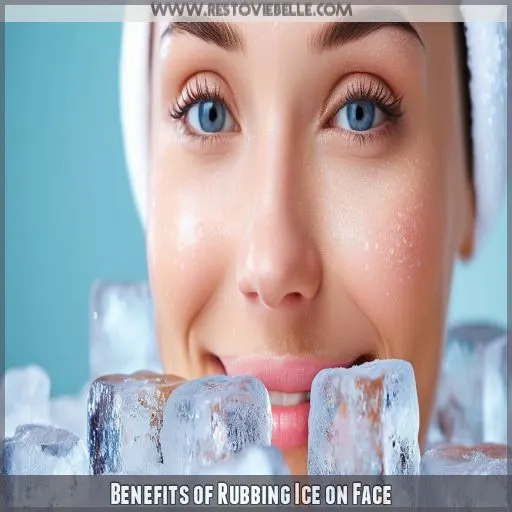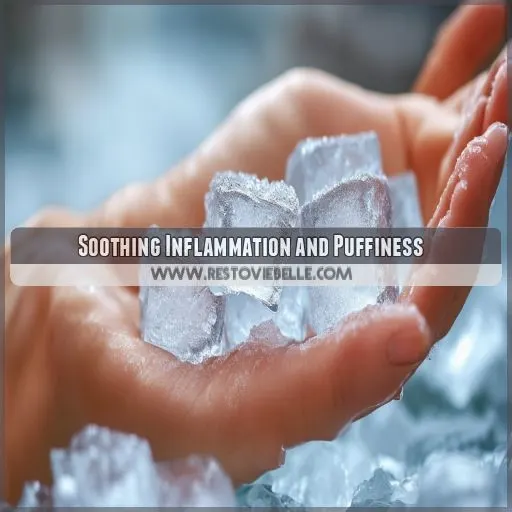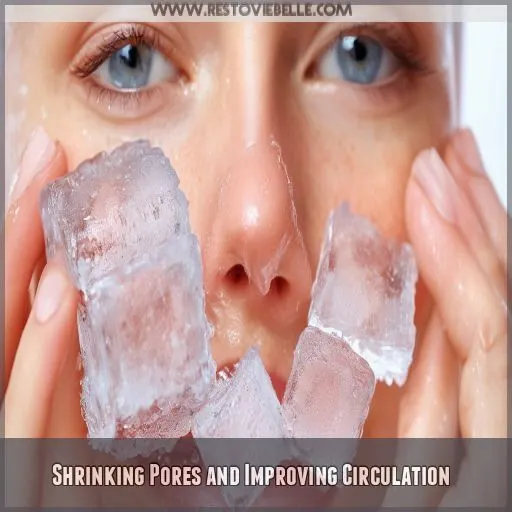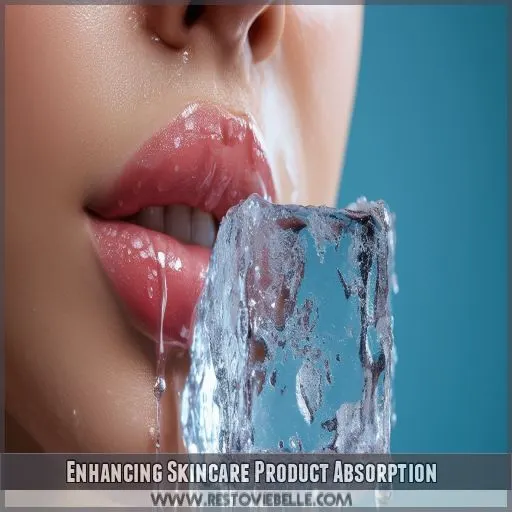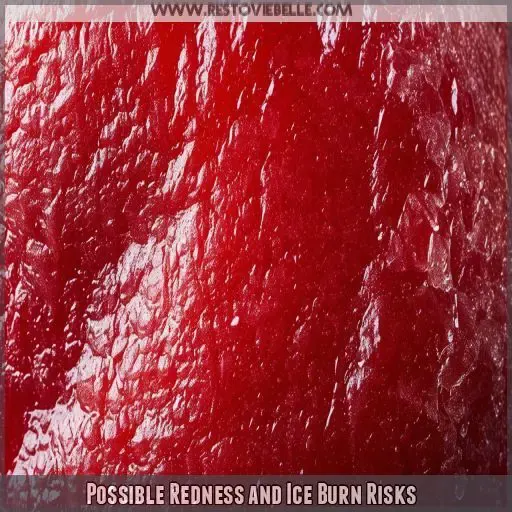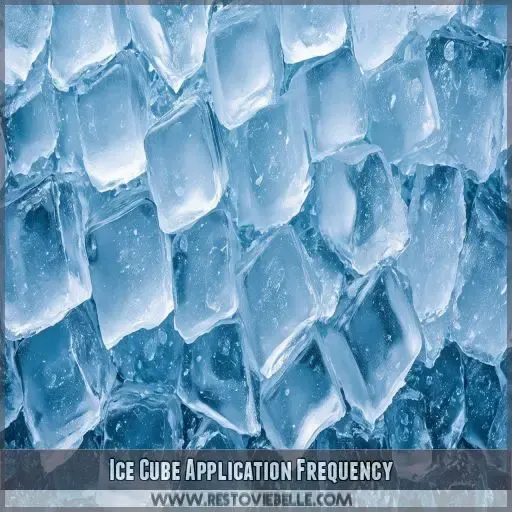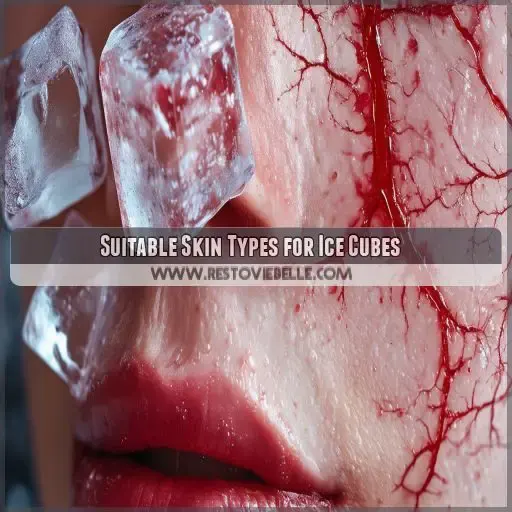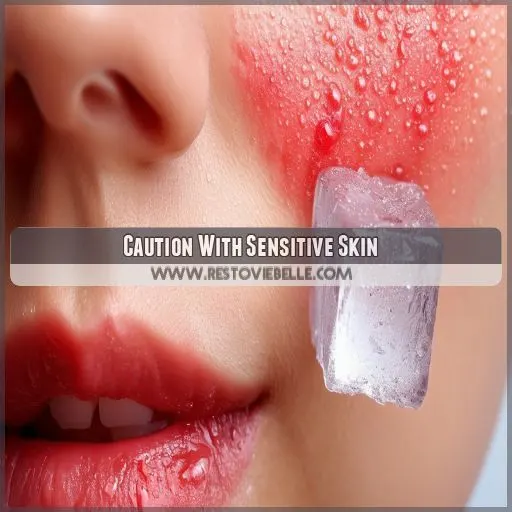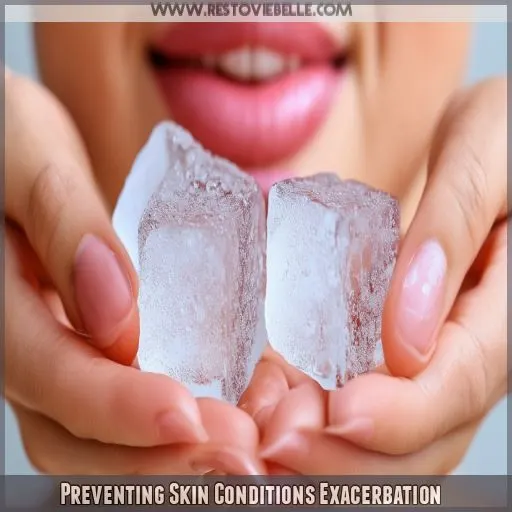This site is supported by our readers. We may earn a commission, at no cost to you, if you purchase through links.
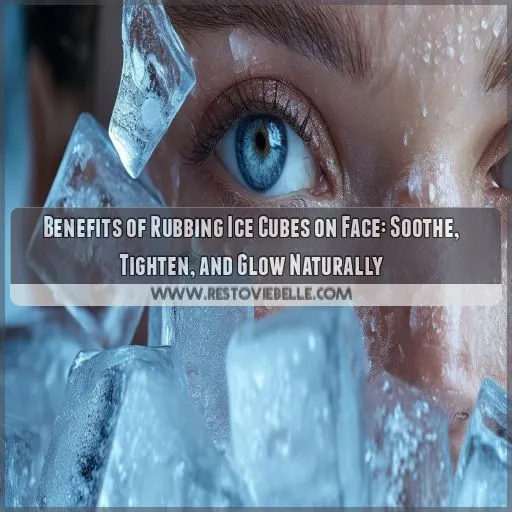
This simple technique can soothe inflammation, tighten pores, and boost circulation for a natural glow. You’ll be amazed at how this icy treatment can transform your complexion.
Table Of Contents
- Key Takeaways
- Benefits of Rubbing Ice on Face
- Soothing Inflammation and Puffiness
- Shrinking Pores and Improving Circulation
- Enhancing Skincare Product Absorption
- Possible Redness and Ice Burn Risks
- Ice Cube Application Frequency
- Suitable Skin Types for Ice Cubes
- Caution With Sensitive Skin
- Preventing Skin Conditions Exacerbation
- Consulting Dermatologist for Concerns
- Frequently Asked Questions (FAQs)
- Can I use ice cubes on my face daily?
- How long should I rub ice on my face?
- What are the downsides of icing your face?
- What are the disadvantages of ice cubes on the face?
- Can ice cube facials replace professional skincare treatments?
- How long does the effect of ice therapy last?
- Are there alternatives to ice cubes for facial cooling?
- Can ice cube facials help with specific skin conditions?
- Is facial icing safe during pregnancy or breastfeeding?
- Conclusion
Key Takeaways
- Chill out those puffy eyes and angry zits! Rubbing ice on your face is like a mini spa day for your skin, reducing inflammation and shrinking pores faster than you can say "brain freeze."
- Circulation station, all aboard! This frosty facial massage gets your blood pumping, giving you that coveted "I just ran a 5K" glow without breaking a sweat.
- Skincare products, meet your new BFF. Ice therapy preps your skin to soak up serums and moisturizers like a thirsty sponge, making your fancy lotions and potions work overtime.
- Easy does it, ice queen! While this cool trick can work wonders, remember: too much of a good thing can leave you looking like a startled snowman. Moderation is key, and when in doubt, ask a pro.
Benefits of Rubbing Ice on Face
Rubbing ice cubes on your face can provide several benefits, including reducing skin inflammation, minimizing pore size, and boosting circulation. These effects can lead to a soothed, tightened, and naturally glowing complexion, making ice cube facials a simple yet effective addition to your skincare routine.
Skin Inflammation Reduction
Rubbing ice cubes on your face can effectively reduce skin inflammation. This cold therapy technique offers several benefits:
- Soothes acne-prone skin
- Calms irritated complexions
- Diminishes redness and swelling
Pore Size Minimization
Rubbing ice on your face reduces inflammation and minimizes pore size. This cold treatment tightens your skin, making pores appear smaller. As you gently massage with ice, you’re effectively sculpting your face and promoting lymphatic drainage. While effective, remember there are alternatives and precautions to consider for best results and safety.
Circulation Boost Effects
When you rub ice on your face, you’re giving your skin a circulation boost. The cold constricts blood vessels, then rapidly dilates them as your skin warms up. This process increases blood flow and oxygenation, enhancing your skin’s health and radiance. Using an ice roller or practicing skin icing can lead to a natural, healthy glow.
Soothing Inflammation and Puffiness
Now that you’re familiar with the general benefits, let’s explore how ice can be your skin’s best friend in reducing inflammation and puffiness. You’ll be amazed at how this simple cold therapy can work wonders for your complexion.
Ice facials can substantially reduce acne, provide sunburn relief**, and manage puffiness effectively. However, if you’re dealing with rosacea, proceed with caution.
The soothing effect of ice on inflamed skin is remarkable, often providing instant relief. By constricting blood vessels, it helps calm irritated areas and reduce swelling, giving you a refreshed, less puffy appearance.
Shrinking Pores and Improving Circulation
Rubbing ice cubes on your face can work wonders for shrinking pores and improving circulation. As you glide the cool cubes across your skin, they cause blood vessels to constrict, tightening pores and giving you a smoother complexion.
This chilly treatment also kickstarts your circulation, bringing a healthy glow to your face. It’s like giving your skin a rejuvenating wake-up call!
The cold can even help sculpt your cheekbones, creating a more defined look.
For an extra boost, try freezing antioxidant-rich green tea to nourish your skin while you ice.
Enhancing Skincare Product Absorption
When you rub ice cubes on your face, you’re not just cooling down—you’re prepping your skin for better product absorption. The cold therapy temporarily tightens pores and boosts circulation, creating the perfect canvas for your skincare routine. After icing, your skin becomes more receptive to serums and moisturizers.
To maximize this benefit, choose smooth ice cubes and gently massage your face using upward strokes. Follow up with your favorite products immediately after icing.
This technique can enhance product penetration, potentially reducing fine lines and promoting a healthy, glowing complexion. Remember, consistency is key for good skin health results.
Possible Redness and Ice Burn Risks
While icing can enhance product absorption, it’s essential to be aware of potential risks. Don’t let your quest for glowing skin turn into a frosty fiasco!
Prolonged or direct ice contact can lead to redness, irritation, and even ice burns. If you’ve got sensitive skin or broken capillaries, tread carefully. Recent facial procedures? Hold off on the ice for now.
Keep your ice cube temperature moderate and limit application duration to avoid these chilly pitfalls. After icing, pamper your skin with gentle post-icing care to soothe any potential irritation.
Ice Cube Application Frequency
You shouldn’t overdo ice cube treatments. Limit your face icing to once daily, especially if you’re targeting acne or under-eye bags. For most skin types, 3-5 times a week is plenty. If you have sensitive skin, start with just once or twice weekly. Watch how your skin reacts and adjust accordingly.
Some people find alternating ice with warm compresses helpful for breakouts.
If you’re unsure about frequency or have specific concerns, it’s always best to consult a dermatologist for personalized advice.
Suitable Skin Types for Ice Cubes
Ice cube therapy isn’t a one-size-fits-all solution, but it can work wonders for certain skin types. If you’ve got younger skin that’s prone to acne or oiliness, you’re in luck. The cold can help tame those breakouts and reduce excess sebum. Even dry skin can benefit, as icing can boost circulation and product absorption.
Celebs like Bella Hadid and Kate Moss swear by it, channeling their inner Joan Crawford. For an extra boost, try freezing green tea cubes.
While Glacial Rx offers professional-grade treatments, at-home icing can be an effective, budget-friendly alternative for many skin types.
Caution With Sensitive Skin
While ice cubes can work wonders for some, you’ll need to tread carefully if you’ve got sensitive skin. Your delicate complexion might not take kindly to the icy shock, potentially leading to redness or even ice burn.
Instead of chasing that healthy glow, you could end up with irritation, especially in the under-eye region. If you’re prone to sensitivity or dealing with cystic acne, consider gentler alternatives like chamomile tea compresses.
When in doubt, consult a dermatologist before giving your face the big chill. They’ll help you navigate the icy waters of skincare safely.
Preventing Skin Conditions Exacerbation
While icing can be beneficial, it’s essential to prevent worsening skin conditions. Be cautious if you’re prone to rosacea flare-ups or have sensitive skin. To avoid ice burn and skin irritation:
- Use a barrier like a soft cloth or paper towel
- Limit icing sessions to 1-2 minutes
- Always follow up with a gentle moisturizer
For a gentler approach, try freezing rosehip seed tea or iced coffee cubes. Remember, "No wire hangers!" isn’t just a Mommie Dearest quote – it applies to ice, too. Don’t go overboard, or you’ll be yelling at your skin later.
Consulting Dermatologist for Concerns
If you’re uncertain about using ice on your face, it’s best to consult a dermatologist. They’ll assess your skin sensitivity and provide personalized guidance suited to your specific concerns.
A professional can help determine if ice therapy is right for you, especially if you have existing skin conditions that might be exacerbated. They’ll also guide you on proper techniques and frequency of use.
Don’t hesitate to reach out for expert guidance!
Frequently Asked Questions (FAQs)
Can I use ice cubes on my face daily?
You can use ice cubes daily, but caution’s key. Wrap them in a soft cloth and limit application to 1-2 minutes. It’s not for everyone, though – if you’ve got sensitive skin or certain conditions, consult a dermatologist first.
How long should I rub ice on my face?
You shouldn’t rub ice on your face for more than 1-2 minutes at a time. Limit sessions to 5-10 minutes total, moving the ice in circular motions. Always use a cloth barrier to protect your skin.
What are the downsides of icing your face?
You’ll risk ice burns and skin damage if you’re not careful. Overdoing it can cause redness, irritation, and broken capillaries. It’s not suitable for sensitive skin or certain conditions. Always wrap ice and limit application time.
What are the disadvantages of ice cubes on the face?
You’ll risk ice burns, skin irritation, and broken capillaries if you’re not careful. Overdoing it can worsen certain skin conditions and cause redness. It’s not suitable for sensitive skin types, so proceed with caution.
Can ice cube facials replace professional skincare treatments?
While ice cube facials can offer some benefits, they can’t replace professional treatments. You’ll still need expert care for targeted skincare concerns. Ice facials complement, but don’t substitute, professional treatments that address specific skin issues more effectively.
How long does the effect of ice therapy last?
You’ll be astounded by the instant transformation! Ice therapy’s effects typically last 2-4 hours. You’ll notice reduced puffiness, tighter pores, and a radiant glow. For longer-lasting results, incorporate it into your daily skincare routine.
Are there alternatives to ice cubes for facial cooling?
You’ve got options beyond ice cubes for facial cooling. Try chilled jade rollers, cold spoons, gel masks, or frozen tea bags. These alternatives offer similar benefits and can be gentler on sensitive skin. Experiment to find what works best for you.
Can ice cube facials help with specific skin conditions?
Picture your skin as a calm lake after a storm. Ice cube facials can help soothe acne, reduce inflammation, and shrink pores. They’re particularly effective for oily or acne-prone skin, but caution’s needed for sensitive or rosacea-prone complexions.
Is facial icing safe during pregnancy or breastfeeding?
While facial icing is generally safe during pregnancy and breastfeeding, it’s best to consult your doctor first. You’ll want to be extra cautious, using gentle pressure and avoiding sensitive areas. Always wrap ice in a soft cloth.
Conclusion
As calm as a cucumber, the benefits of rubbing ice cubes on face offer a rejuvenating approach to skincare. You’ve learned how this simple technique can reduce inflammation, tighten pores, and boost circulation for a natural glow.
While it’s not suitable for everyone, especially those with sensitive skin, ice therapy can be a valuable addition to your routine.
Remember to use caution, follow proper techniques, and consult a dermatologist if you have concerns. With consistent application, you might just find that ice is your new secret weapon for radiant skin.

